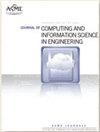一种用机床控制器数据分割数控数据的自动化方法
IF 2.6
3区 工程技术
Q2 COMPUTER SCIENCE, INTERDISCIPLINARY APPLICATIONS
Journal of Computing and Information Science in Engineering
Pub Date : 2023-11-08
DOI:10.1115/1.4064036
引用次数: 0
摘要
开发更加自动化的工业数字线程是实现智能制造和工业4.0愿景的关键。数字线程允许跨产品生命周期阶段的有效共享。目前的技术在将下游数据(如制造和检验信息)与设计联系起来以做出更好的决策方面不够稳健。作为回应,我们之前提出了一种方法,将数控(NC)代码(表示机床指令的标准)与MTConnect中表示的控制器数据相一致,MTConnect提供了一个词汇表,用于概括来自不同机床和设备的执行日志。本文扩展了我们以前的工作,通过使用k-means聚类算法自动化工具识别来改进数据的对齐。在此过程中,我们比较了不同的距离技术来分析两个数据集(即NC代码和MTConnect数据)的时空配准。然后,我们通过误差测量技术来评估我们的方法的效率,该技术反映了校准的质量。最后,我们将我们的方法应用到一个案例研究中,该案例研究包括经过验证的过程计划和真实的执行数据,这些数据来自美国国家标准与技术研究所主办的智能制造系统测试平台。分析表明,与其他对准技术相比,动态时间翘曲能以最小的误差获得最佳的点配准效果。本文章由计算机程序翻译,如有差异,请以英文原文为准。
An automated approach for segmenting numerical control data with controller data for machine tools
Abstract Developing a more automated industrial digital thread is vital to realize the smart manufacturing and Industry 4.0 vision. The digital thread allows for efficient sharing across product lifecycle stages. Current techniques are not robust in relating downstream data, such as manufac- turing and inspection information, back to design for bet- ter decision making. In response, we previously presented a methodology that aligns numerical control (NC) code, a standard for representing machine tool instructions, to controller data represented in MTConnect, a standard that provides a vocabulary for generalizing execution logs from different machine tools and devices. This paper ex- tends our previous work by automating the tool identifi- cation using a k-means clustering algorithm to refine the alignment of the data. In doing so, we compare differ- ent distance techniques to analyze the spatial-temporal registration of the two datasets, i.e., the NC code and MTConnect data. Then, we assess the efficiency of our method through an error measurement technique that ex- presses the quality of the alignment. Finally, we apply our methodology to a case study that includes verified process plans and real execution data, derived from the Smart Manufacturing Systems Test Bed hosted at the National Institute of Standards and Technology. Our anal- ysis illustrates that dynamic time warping achieves the best point registration with the least errors compared with other alignment techniques.
求助全文
通过发布文献求助,成功后即可免费获取论文全文。
去求助
来源期刊
CiteScore
6.30
自引率
12.90%
发文量
100
审稿时长
6 months
期刊介绍:
The ASME Journal of Computing and Information Science in Engineering (JCISE) publishes articles related to Algorithms, Computational Methods, Computing Infrastructure, Computer-Interpretable Representations, Human-Computer Interfaces, Information Science, and/or System Architectures that aim to improve some aspect of product and system lifecycle (e.g., design, manufacturing, operation, maintenance, disposal, recycling etc.). Applications considered in JCISE manuscripts should be relevant to the mechanical engineering discipline. Papers can be focused on fundamental research leading to new methods, or adaptation of existing methods for new applications.
Scope: Advanced Computing Infrastructure; Artificial Intelligence; Big Data and Analytics; Collaborative Design; Computer Aided Design; Computer Aided Engineering; Computer Aided Manufacturing; Computational Foundations for Additive Manufacturing; Computational Foundations for Engineering Optimization; Computational Geometry; Computational Metrology; Computational Synthesis; Conceptual Design; Cybermanufacturing; Cyber Physical Security for Factories; Cyber Physical System Design and Operation; Data-Driven Engineering Applications; Engineering Informatics; Geometric Reasoning; GPU Computing for Design and Manufacturing; Human Computer Interfaces/Interactions; Industrial Internet of Things; Knowledge Engineering; Information Management; Inverse Methods for Engineering Applications; Machine Learning for Engineering Applications; Manufacturing Planning; Manufacturing Automation; Model-based Systems Engineering; Multiphysics Modeling and Simulation; Multiscale Modeling and Simulation; Multidisciplinary Optimization; Physics-Based Simulations; Process Modeling for Engineering Applications; Qualification, Verification and Validation of Computational Models; Symbolic Computing for Engineering Applications; Tolerance Modeling; Topology and Shape Optimization; Virtual and Augmented Reality Environments; Virtual Prototyping

 求助内容:
求助内容: 应助结果提醒方式:
应助结果提醒方式:


